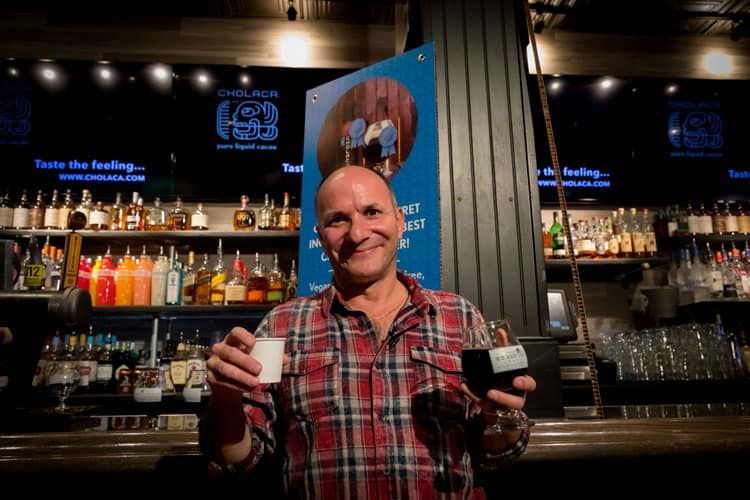Cholaca keeps chocolate natural


BOULDER — Some people think of chocolate as a love elixir. Some tag it the ticket to romance. And everyone knows that nothing says Valentine’s Day better than a big red heart box filled with melt-in-your-mouth deliciousness.
From a laboratory perspective, it’s the phenylethylamine in chocolate that makes it the euphoric treat it is. PEA stimulates the production of endorphins and increases dopamine — creating a combined result of feel-good pleasure. What could be better than packaging that feeling in a rich velvety taste?
From Ira Leibtag’s perspective, good chocolate is the result of good science. His unique process of making chocolate keeps the ingredients to a minimum and eliminates additives that a lot of chocolate producers rely on. Leibtag’s company — Cholaca — has been emulsifying cacao in water rather than with preservatives since 2012.
SPONSORED CONTENT
Because of Cholaca’s limited ingredients and processing, it’s become an appealing way for craft brewers to create masterpieces like chocolate porters and stouts. “There is definitely an increase in chocolate beers at this time of year because brewers want to launch them on Valentine’s Day,” Leibtag said.
Cholaca is the ingredient of choice for about 450 different breweries in places that include the United States, Canada, England, Ireland, South Korea and Puerto Rico.
Using no more than three ingredients — cacao, water and with or without coconut sugar — liquid Cholaca makes it easier for brewers to use chocolate without concerns that organisms like salmonella, E. coli and botulism will mess up a batch. The bacterias love to grow when liquid hits the cacao nibs or powders that are commonly used in the fermentation process.
“We liquefy our chocolate, emulsify it with water and remove harmful organisms by pasteurizing it,” Leibtag said. The liquid form allows brewers to keep solid chocolate out of the fermentation process. “When you use solid chocolate, microorganisms are dormant until you add water — that’s when you add life,” he explained, referring to the growth of bacteria.
Cacao nibs, which are basically chocolate in its purest form before anything else is added, are dried bits of cacao beans. When they’re added to a fermenter, the two-week process can result in unplanned-for-flavors in the finished product. Since Cholaca is already a liquid, it can skip those unexpected results and go right into the brite or secondary tank. “No fermentation is needed because it’s not an extracted flavor but an enhanced flavor.”
Using liquid Cholaca makes the clean-up for brewers easier too. When solid chocolate is added to fermenters, clogged pipes, hoses and valves tend to make cleanup a dreaded task.
For those chocolate lovers who aren’t beer drinkers, liquid Cholaca that’s ready for the pouring can be picked up at places like Whole Foods, Alfalfa’s, Natural Grocers: Vitamin Cottage and Lucky’s Market. Ozo’s Coffee Co. and other coffee shops add a shot of the elixir to cups of java to enhance the flavor.
In addition to Cholaca’s appeal as a liquid ingredient for the beverage market, it appeals to bakers, food manufacturers and chocolatiers with solid 100 percent pure cacao baking wafers.
As an added bonus, the appeal of Cholaca goes beyond flavor regardless of how it’s enjoyed. Where Cholaca’s cacao comes from and the trail it leaves behind make it a globally attractive product.
Leibtag’s chocolate starts out as an organic product that’s regeneratively farmed in sustainable economic partnerships with farmers in Ecuador.
“What makes us higher quality is the fact that our cacao beans are shade grown, single origin, kosher, organic and fair trade,” he said. “We deal directly with co-ops and farmers, and we don’t buy secondary beans.”
As a fair trade company, Cholaca builds on long-term partnerships with leading regenerative farming cooperatives focused on continuing the social, economic and ecological practices. By purchasing cacao with a single-origin focus, the company is repairing relationships most farmers have suffered from industry exploitation and nourishing ongoing trade that supports both the buyer and the sellers.
Challenges Cholaca contends with include keeping a balance of reliable sources, processing and transporting the product to its warehouse and doing it all in a way that keeps the production chain affordable for all, according to Leibtag.
“Regeneration relies on volume,” he said. It takes big orders to be able to grow back the rainforests.

BOULDER — Some people think of chocolate as a love elixir. Some tag it the ticket to romance. And everyone knows that nothing says Valentine’s Day better than a big red heart box filled with melt-in-your-mouth deliciousness.
From a laboratory perspective, it’s the phenylethylamine in chocolate that makes it the euphoric treat it is. PEA stimulates the production of endorphins and…
THIS ARTICLE IS FOR SUBSCRIBERS ONLY
Continue reading for less than $3 per week!
Get a month of award-winning local business news, trends and insights
Access award-winning content today!
